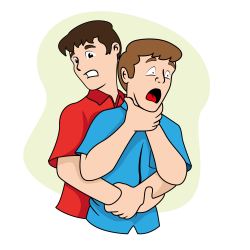Dr. Henry Heimlich, thoracic surgeon and creator of the famed maneuver that saves people from choking to death, died at the age of 96.
In his own words, he best elucidates the profound nature of this triumph:
“What makes the Heimlich Maneuver particularly special is this: it is accessible to everyone. Because of its simplicity—and the fact that it works when performed correctly—just about anyone can save a life. Each of us can save the life of a stranger, a neighbor, a spouse, or a child. And it can happen anywhere—in restaurants, homes, ballparks—you name it. You see, you don’t have to be a doctor to save a life. You just have to have knowledge and the instinct to respond in a crisis.”
Publishing his method in the June 1974 issue of Emergency Medicine was the catalyst that led to multiple stories appearing nationwide over the success of his technique. His maneuver is credited to saving countless lives. Of note, per his website, the list includes President Ronald Reagan, Cher, Elizabeth Taylor, Carrie Fisher and New York Mayor Ed Koch, to name a few. While others like Clint Eastwood and Tom Brokaw performed it to save a life. Dr. Heimlich even used it to save a life as recently as this year.
Due to his tremendous contribution to the field of medicine and public health, he was the recipient of the coveted Lasker Award in 1984.
His innovations extended well beyond this measure. The Heimlich Chest Drain Valve, introduced in 1964, is credited to saving innumerable lives since it manages to get blood and air out of the chest cavity of soldiers shot there. He developed the Heimlich MicroTrach, a tiny tube that has certain advantages to delivering oxygen into the trachea and effectively the lungs. The list goes on of his countless interventions that endeavored to seek simple solutions to saving lives.
Like most pioneers or visionaries, his trajectory was not without controversy, in particular, the latter years of his life when he pivoted to concerning himself with cancer and HIV therapies, for example, or desiring to extend his maneuver to include other disease states like drowning and asthma. He theorized injecting HIV-infected patients with malaria might mount an effective immune response to combat the illness. This met resistance with The Centers for Disease Control (CDC) and others so he carried on his clinical trials outside of the United States.
His favorite phrase being, “If all of your peers understand what you have done, you are not creative.” He employed many creative efforts to enhance survival. The history of his extensive litany of intellectual and practical pursuits, debates, conflicts, adventures and accolades prove a fascinating read if you have the time.
Choking Prevention…
To all of us who lead perfectly imperfect lives, let’s utilize his indelible memory to continue the vast influence of his groundbreaking technique and reinvigorate awareness of the importance of choking education and prevention.
- Choking is the 4th leading cause of unintentional injury death
- 2,751 of the 4,864 deaths from choking in 2013 were in those over 75
- Food is often the culprit in the elderly — living alone, dentures, those with underlying swallowing or neurological disorders and so forth…
- For children, toys, food and household items can be hazardous—discuss with your pediatrician dangers and prevention. The New York Department of Health provides an excellent guide to prevention here. Or, the American Academy of Pediatrics policy statement here.
- Learn CPR— make it a family event and support efforts to mandate it in schools
Let’s become a nation of superheroes and arm ourselves with the vital tools necessary to respond in a crisis. Not only will this save a life, but it certainly will forever change yours, the victim’s and their family's lives. I extensively address this in Want a Nation of Super Heroes? Early CPR Makes Every Second Count.

